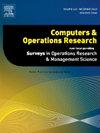具有时变电弧容量的危险品车辆路径问题
IF 4.3
2区 工程技术
Q2 COMPUTER SCIENCE, INTERDISCIPLINARY APPLICATIONS
引用次数: 0
摘要
在人口密度较大的路段上运输满载危险物品的车辆,或者同一路段上同时存在多辆危险物品车辆,会显著增加运输风险。为了保证运输危险物品的车辆在道路上的安全运行,我们基于带时间窗的时变车辆路径问题(TDVRPTW)建立了一个数学框架。该框架将每个路段视为一个独立的实体,并结合其外部环境随时间的变化。具体而言,它将电弧容量与时间相关属性相结合,形成时间相关电弧容量(TDAC)。TDAC通过限制允许进入的有害物质的总量来控制每个路段的风险。根据一天中不同时间段的具体外部环境进行限制。为了解决路径搜索中的这些时变因素,我们开发了一种算法,称为具有时变权重的Dijkstra算法的时变变体。然后,我们将该算法集成到一个双目标禁忌搜索方法中来解决TDVRPTW问题。我们利用增广约束方法求解小尺度问题,并将结果与启发式算法进行了比较。随后,通过在不同尺度的道路网络上进行计算实验,验证了启发式算法的有效性。结果表明,我们的方法可以实现更合理的风险分布,实现道路的交错利用,有效地将系统的整体风险和网络中每条道路的风险控制在较低的水平。此外,在不显著增加总成本的情况下实现这些好处。本文章由计算机程序翻译,如有差异,请以英文原文为准。
A hazardous materials vehicle routing problem with time-dependent arc capacity
The transportation of vehicles fully loaded with hazardous materials on road segments with high population density, or the simultaneous presence of multiple hazardous materials vehicles on the same road, significantly increases transportation risk. To ensure the safe operation of vehicles carrying hazardous materials on the road, we develop a mathematical framework based on the time-dependent vehicle routing problem with time windows (TDVRPTW). This framework treats each road segment as an independent entity and incorporates the variation of its external environment over time. Specifically, it integrates the arc capacity with time-dependent attributes, forming the time-dependent arc capacity (TDAC). The TDAC controls the risks in each road segment by implementing restrictions on the total quantity of hazardous materials allowed to enter. The restriction is based on the specific external environments during different time periods of the day. To address these time-dependent factors in path searching, we develop an algorithm called the Time-Dependent Variant of Dijkstra’s Algorithm with Time-Dependent Weight. We then integrate this algorithm into a bi-objective tabu search approach to solve the TDVRPTW. We utilized the augmented -constraint method to solve small-scale problems and compared the results with those obtained from heuristic algorithms. Subsequently, by conducting computational experiments on road networks of various scales, we validate the efficiency of our heuristic algorithm. The results show that our method can achieve a more reasonable distribution of risks, enable staggered utilization of roads, and effectively control the overall risk of the system and the risk of each road in the network at a relatively low level. Moreover, these benefits are achieved without significantly increasing the total cost.
求助全文
通过发布文献求助,成功后即可免费获取论文全文。
去求助
来源期刊

Computers & Operations Research
工程技术-工程:工业
CiteScore
8.60
自引率
8.70%
发文量
292
审稿时长
8.5 months
期刊介绍:
Operations research and computers meet in a large number of scientific fields, many of which are of vital current concern to our troubled society. These include, among others, ecology, transportation, safety, reliability, urban planning, economics, inventory control, investment strategy and logistics (including reverse logistics). Computers & Operations Research provides an international forum for the application of computers and operations research techniques to problems in these and related fields.
 求助内容:
求助内容: 应助结果提醒方式:
应助结果提醒方式:


